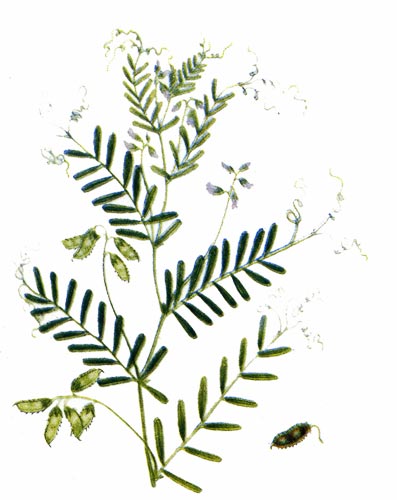Weeds
Vicia hirsuta (L.) S. F. Gray - Strangle-Tare.
Systematic position.
Family Fabaceae, genus Vicia L.Synonym.
Ervum hirsutum L.Biological group.
Annual spring-summer plant.Morphology and biology.
Height 20-90 (140) cm. Stems dispersly decumbent-hirsute, extending or rising, tetrahedral. Leaves are terminated with simple or branchy tendril. Leaflets are 4-8-pairs, situated on petioles, usually linear, 0.5-2 cm in length, 1-3 mm in width, from below hairy only or bare. Inflorescence with 2-8 flowers; flowers are petty, 3-4 (5) mm in length. Calyx is campaniform; teeth of the calyx are awl-shaped, acute, slightly longer than tube. Corolla is whitish. Fruits are beans, drooping, flat, shortly soft-fluffy (var. eriocarpa Gr. et Godr.) or bare (var. leiocarpa Vis.), pale olive-green to black-brown, with 2 (rarely 1-3) seeds. Seeds are almost spherical, slightly flattened, 1.5-3 mm in diameter, shining, smooth. Flowering since May till July.Ecology.
Shrubs, river banks, fields, shrubs along roads, embankments.Distribution.
Europe, Asia, North Africa; adventive all over the globe.Economic significance.
Weed of crops of grain cultures and flax; frequently occurs, but not abundant, in crops of tilled cultures. Control measures include harrowing of young crops, duly interrow treatments.Related references:
Buch T.G. et al. 1981. Weeds of the Primorskii Territory and their control. Vladivostok: Dalnevostochnoe Publishing House. 256 p. (in Russian).Keller B.A., ed. 1934. Weed plants of the USSR. V. 3. Leningrad: AN SSSR. 448 p. (in Russian).
Komarov V.L., ed. 1948. Flora of the USSR. Moscow & Leningrad: AN SSSR. V. 13: 408-410. (In Russian)
Ulyanova T.N. 1998. Weeds in the flora of Russia and other CIS states. St.Petersburg: VIR. 344 p. (In Russian)


